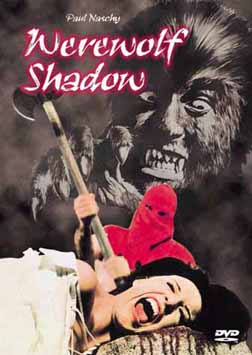 WEREWOLF
SHADOW (1970) (aka THE WEREWOLF VS. THE VAMPIRE WOMEN, WEREWOLF'S SHADOW,
BLOOD MOON)
WEREWOLF
SHADOW (1970) (aka THE WEREWOLF VS. THE VAMPIRE WOMEN, WEREWOLF'S SHADOW,
BLOOD MOON)Director: Leon Klimovsky
Anchor Bay Entertainment
 WEREWOLF
SHADOW (1970) (aka THE WEREWOLF VS. THE VAMPIRE WOMEN, WEREWOLF'S SHADOW,
BLOOD MOON)
WEREWOLF
SHADOW (1970) (aka THE WEREWOLF VS. THE VAMPIRE WOMEN, WEREWOLF'S SHADOW,
BLOOD MOON)On a dark night, a police surgeon
and his assistant remove the bullet from dead Waldemar Daninsky's (Paul Naschy's)
chest, bantering about what legend says could happen. And so it does--the werewolf
is again reborn, making myth fact, and reactivating a beast with an appetite
for blood. Within the first few minutes, three succumb to his bloodlust, the
third being an innocently wandering woman, whom he gnaws at ferociously, tearing
apart her neck. The beast departs, now in search of new victims. We see a close-up
of juicy red blood flowing slowly down her breasts. An unsightly blend of blood
and saliva dangles from his knifelike fangs as he departs. The credits abruptly
arrive, and we are made very aware of the fact that this is "A film of
Leon Klimovsky."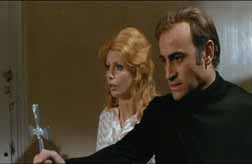
Two young students Genevieve (MARK
OF THE DEVIL barf bag poster girl, Gaby Fuchs) and Elvira (Barbara Cappell)
embark on an outing to search for the remains of one Countess Wandessa (played
by South Carolina-born Paty Shepard), a legendary individual who drank the blood
of young virgins! The girls meet up with Waldemar who resides in an abandoned
old house, not far from the sought after tomb. He provides the girls with cold
cuts and shelter, and shows them were Wandessa is laid out. They open the tomb
to reveal an ancient skeleton, and as bad luck would have it, Elvira cuts her
arm while extracting the silver cross from the corpse. Blood trickles on Wandessa's
face, thus reviving her. Genevieve becomes the first target of the vampire queen.
That same night, as she goes to get a glass of water, an unearthly voice beckons
from beyond. She is routed outside in the forest where the Countess anxiously
awaits. The sweet, innocent looking girl is all too effortlessly lured and netted.
Her wounded arm is extended as Wandessa begins to feed, both parties fully satisfied.
She is now content to be one of the undead as Wandessa embraces he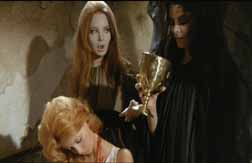 r;
she is now fully inducted.
r;
she is now fully inducted.
Two vampire women are now on the
prowl, as if Waldemar doesn't have enough problems. He falls in love with Elvira,
who is convinced that he must remain chained up at night. Elvira's nightmare
world is also in full swing. She is left alone in the house one night while
Waldemar's curse forces his imprisonment elsewhere. Here, Klimovsky shows his
proficiency at scaring his audience. The helpless girl is visited by the undead
duo, who proceed to cut her throat, allowing blood to flow generously into a
silver chalice. Wandessa and Genevieve take turns nipping at the cup, which
is then tossed freely into the air by the latter. The noise that the empty thing
stirs as it rattles along the cold concrete floor, consummated by her blatant
mouth wiping, and sigh of quenched thirst, is concluded as the vamps perform
a childlike victory dance. This, as well as all of the vampire activity is filmed
in slow motion (a common practice of Spanish horror, and highly effective here).
The scene is interpreted as a dream, as Elvira awakens unharmed.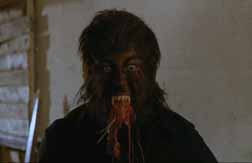
Her dream was a vision of things to come as Genevieve visits for real to put the bite on her. She is saved from the undead world when Waldemar impales Genevieve on a stake, thus releasing the marks from Elvira's neck. It all comes to a close on the dreaded Walpurgis Night. Elvira is chained helpless in the crypt where Wandessa dwells. She is to be made sacrifice, as the Countess has plans on summoning the Devil himself. She almost succeeds--we are greeted by the silhouette of the immense demon (masterfully suggested as a shadow). Its visit is quickly interrupted as the forces of good arrive in the form of the silver cross bearing Waldemar. Wandessa flinches at first, but then welcomes his werewolf transformation, which soon commences. Werewolf and vampire then go at it in a fight to the finish.
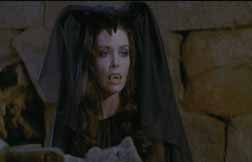 WEREWOLF
SHADOW is a triumph on Klimovsky's part, even though Naschy's script plays around
with the various legends. This only makes the film more unique in its betrayals
of these renowned monsters. Shepard and Cappell are both captivating creepy/attractive
vampires, sporting pale blue faces, extremely long fangs, and black flowing
gowns. The werewolf takes a back seat, but his scenes are invaluable. Waldemar
is also is very important as the film's hero. When he's not on the rampage as
the beast, he's slaying vampires, including his own sister. Excellent make-up,
sets, and locations clearly show why this spawned an affluent era of Spanish
horror films in the 70s.
WEREWOLF
SHADOW is a triumph on Klimovsky's part, even though Naschy's script plays around
with the various legends. This only makes the film more unique in its betrayals
of these renowned monsters. Shepard and Cappell are both captivating creepy/attractive
vampires, sporting pale blue faces, extremely long fangs, and black flowing
gowns. The werewolf takes a back seat, but his scenes are invaluable. Waldemar
is also is very important as the film's hero. When he's not on the rampage as
the beast, he's slaying vampires, including his own sister. Excellent make-up,
sets, and locations clearly show why this spawned an affluent era of Spanish
horror films in the 70s.
For any longtime fan of Paul Naschy,
used to watching his efforts on late-night TV or renting them at "Mom &
Pop" video outlets, Anchor Bay presents a revelation. Never before has
a Naschy title looked so good, and AB's restoration from the original vault
elements finally makes the film look impressive, with stunning clarity and vivid
colors. The original 1.85:1 hard-matted aspect ratio (Anamorphic) is finally
realized, displaying more vital picture information than ever before. Not only
do we get a whole new outlook on the film's appearance, but it's also presented
fully uncut for the first time. The U.S. theatrical version omitted some of
the sex and violence, and several dialog scenes (with no English track) were
also eliminated. All this, plus the original opening and closing music, has
been restored, and the missing dialog scenes are accompanied by English subtitles.
The rest of the mono soundtrack is comprised of the familiar English-synched
track, and its presentation is very clear.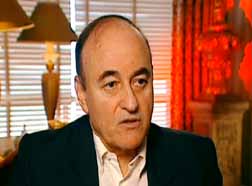
Extras include the 15-minute "Interview With the Werewolf," an excellent, solid conversation with Naschy recorded in 2000. Naschy talks about how he got into acting, how he derived his name, and how he came to write and star in MARK OF THE WOLFMAN in 1968. He also discusses the development of his werewolf character, as well as childhood inspirations (FRANKENSTEIN MEETS THE WOLFMAN). There's also a photo gallery featuring dozens of posters, lobby cards, and video art from various Naschy titles. Also included is a European theatrical trailer, a US TV spot for the film under its WEREWOLF VS. THE VAMPIRE WOMEN title, and a well-written Naschy bio. (George R. Reis)